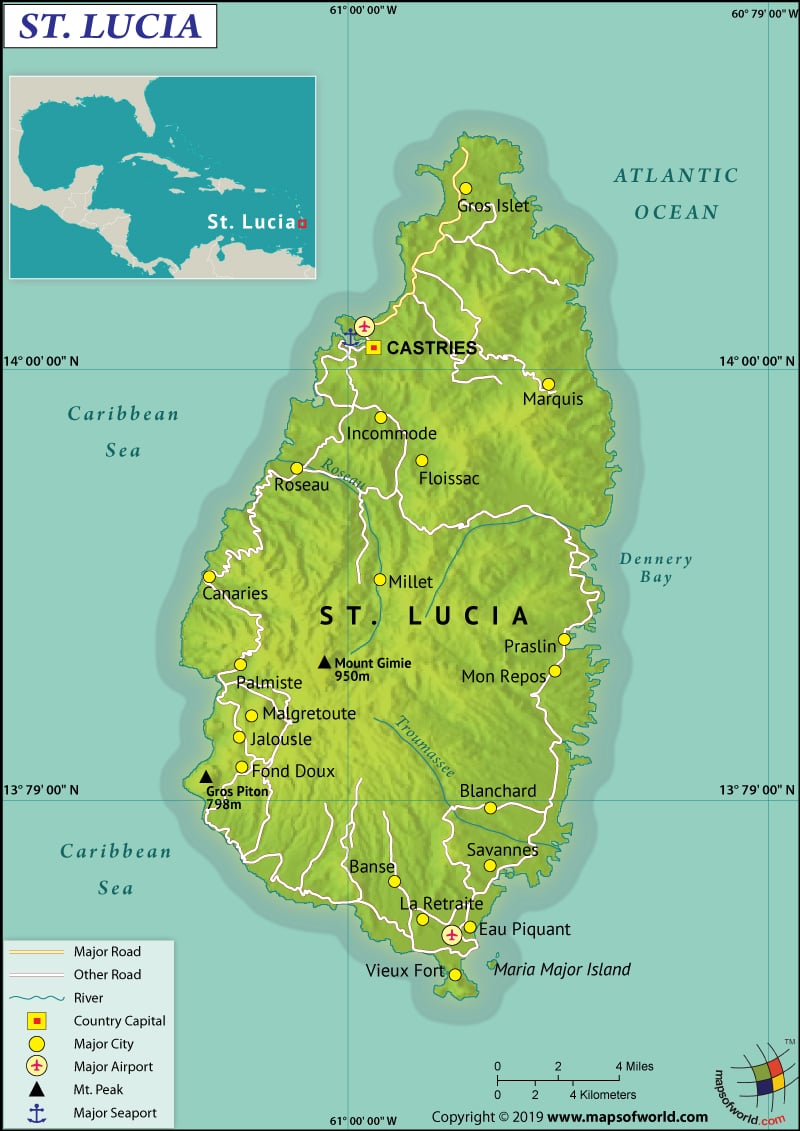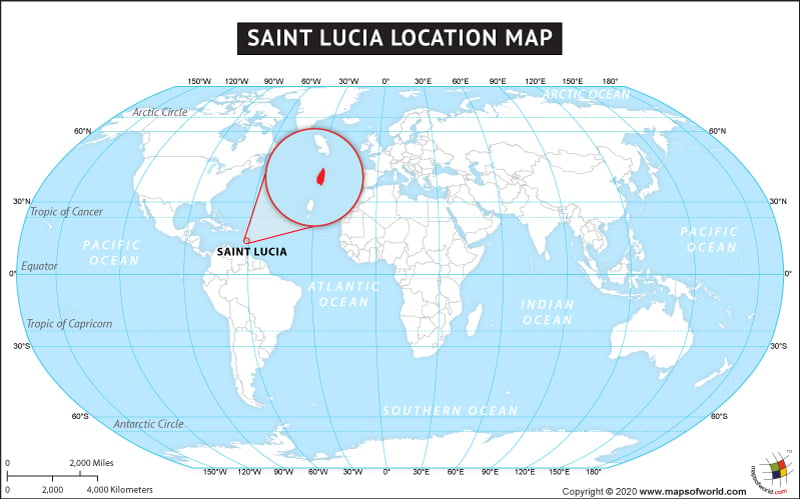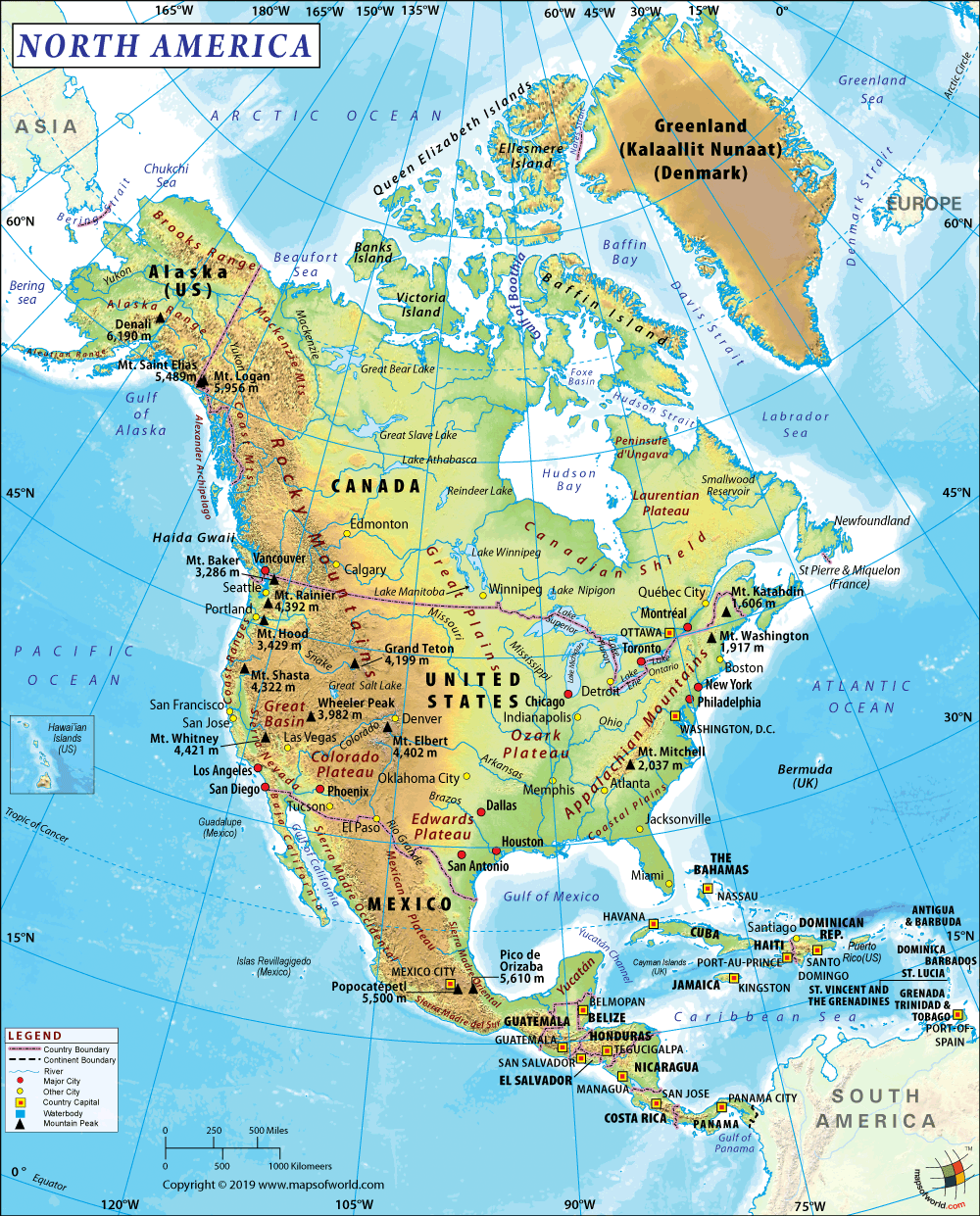What are the Key Facts of Saint Lucia?

|
Official Name |
Saint Lucia |
|
Continent |
North America |
|
Capital |
Castries |
|
Largest City |
Castries |
|
Coordinates |
13.883333, -60.966667 |
|
Area |
238 sq. mi (617 sq. km) |
|
Land Boundaries |
0 mi ( 0 km) |
|
Coastline |
98 mi ( 158 km) |
|
Currency |
East Caribbean dollar (XCD) |
|
Neighboring Countries |
Maritime Neighbor: St. Vincent and the Grenadines, Martinique |
|
Population |
181,889 (2018 est.) |
|
Official Languages |
English |
|
Major Religion |
Christianity |
|
National Day |
30 November (Independence Day) |
|
National Anthem |
“In Plenty and In Time of Need” |
|
Form of Government |
Unitary parliamentary constitutional monarchy |
|
Monarch |
Elizabeth II |
|
Prime Minister |
Allen Chastanet |
|
GDP per capita (PPP) |
$ 13,886.6 (World Bank, 2017) |
|
GDP per capita (nominal) |
$ 10,315.0 (World Bank, 2017) |
|
HDI |
0.747 (2017), Rank: 90 |
|
Literacy Rate (%) |
NA |
|
Space Agency |
NA |
|
Military Expenditure Ranking |
NA (SIPRI, 2017) |
|
No. of Olympic Medals |
0 (as of 2018) |
|
Driving Side |
left |
|
Calling Code |
+1 758 |
|
Time Zone |
UTC-4 |
|
Internet TLD |
.lc |
Where is Saint Lucia?
Saint Lucia is an island country in the Caribbean that is located between the North Atlantic Ocean and the Caribbean Sea. It is located to the south of Martinique, northwest of Barbados, and north/northeast of the island of Saint Vincent.
What is the Geography of Saint Lucia?
The total area of Saint Lucia is 617 sq. km (238 sq. mi), out of which 606 sq. km (234 sq. mi) is land area and 10 sq. km (4 sq. mi) is water area. It has no land boundary but 158 km (98 mi) long coastline. The terrain of Saint Lucia is volcanic and mountainous. It also consists of broad, fertile valleys.
While Mount Gimie (located in the south-central mountain range) is the highest elevation point of the country at 948 m (3,110 ft), the lowest elevation point is the Caribbean Sea at 0 m (0 ft).
Saint Lucia is made up of many small islands, comprising the Windward Islands of the Caribbean. The dense jungle, as well as central ridge of forested mountains, dominates the landscape. On the southwestern coast of Saint Lucia, the famous twin peaks of Gros Piton and Petit Piton are located. Mount Fortune is another major mountain.
Dozens of small rivers drain this island nation to the sea. Some of the major ones that drain the island are Mabouya, Cul de Sac, Canelles, and Soufriere. Sandy beaches and small bays ring the island by miles. The longest river in Saint Lucia is the Roseau River.
This island country in the Lesser Antilles has a tropical climate, which remains hot throughout the year. However, during January-mid-April, the weather remains cool and dry. The northeast trade winds blow constantly and steadily during the dry season at moderate intensity.
Mid-June-November is the rainy season and the weather remains hot and humid. During the wet season, the northeast trade winds blow more irregularly. There may have been some breaks in the blowing of the wind, thereby increasing the feeling of sultriness.
Two transitional periods are there between the wet and dry seasons and they are December-to-early-January and mid-April-to-mid-June. During December-to-early-January, the northeast wind starts blowing. It leads to the improvement of weather and the temperature drops a bit. The frequency of rainfall gradually increases from mid-April to Mid-June. The temperature also starts to rise from this period.
Altitude and location have an important role in the extent of rainfall. The higher elevations in the inland areas get more rainfall than that of the coastal areas. The regions located near the mountains get more rainfall than those that are far away from them.
Abundant as well as more frequent rainfall takes place during July-November. However, during February-April, the extent of rainfall is frequent and shorter. More abundant rainfall takes place on the slopes of Mount Gimie.
Saint Lucia gets adequate sunshine throughout the year, especially along the coastal areas. The sea water remains warm across the year. While during February-March the water temperature revolves around 26 °C (79 °F), the same remains 29 °C (84 °F) during September-October.
Hurricanes affect this island nation in the Caribbean region. The tropical storms and cyclones generally pass through the island during June-November. However, hurricanes are most likely to hit Saint Lucia during August-October.
If you want to visit the country, December-April (especially February-April) is the best time.
What is the Economy of Saint Lucia?
Saint Lucia has emerged as a hotspot in the offshore banking and tourism industries. They have become successful in attracting foreign business as well as investment. Tourism is the most important aspect of the economy because it accounts for 65% of GDP and also is the main source of income/jobs for the people in Saint Lucia. There is a diverse manufacturing sector in this island nation. The main agricultural items for export are bananas, avocados, mangoes, etc.
In 2018, the nominal GDP of the economy grew at 0.9% to US$1,922 million. However, in 2017, the economy grew at a rate of 2.6%. The major export items are bananas, video displays, refined petroleum, flavoured water, beer, etc. The major import items are crude/refined petroleum, hard liquor, poultry meat, cars, etc. In 2017, the economy had a negative balance of trade as it imported US$77.6 million of goods and exported US$1.71 billion of goods.
The rate of unemployment in the country was 20.87% in 2018. As per UNICEF, there is 18.7% household and 25.1% individual poverty in Saint Lucia.
What is the Transportation System of Saint Lucia?
Over 1,210 km (752 mi) long roadway network is present in the country, out of which 847 km (526 mi) is paved and 363 km (226 mi) is unpaved. Vieux-Fort, Cul-de-Sac, and Castries are the major seaports of Saint Lucia. There are two airports in this Caribbean country and both of them have paved runways. These airports are Hewanorra International Airport and George F. L. Charles Airport (which was earlier known as Vigie Airport).
What International Organizations is Saint Lucia part of?
WTO, UN, NAM, UNESCO, WHO, ILO, Petrocaribe, ACP, AOSIS, C, Caricom, CD, CDB, CELAC, FAO, G-77, IBRD, ICAO, ICCt, ICRM, IDA, IFAD, IFC, IFRCS, IMF, IMO, Interpol, IOC, ISO, ITU, MIGA, OAS, OECS, OIF, OPANAL, OPCW, UNCTAD, UNIDO, UPU, WCO, WIPO, WMO, ITUC (NGOs), WFTU (NGOs)


![]()
